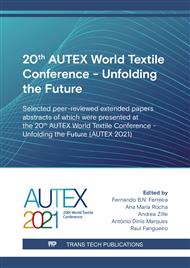[1]
U. Habiba, A.M. Afifi, A. Salleh, e B.C. Ang, Chitosan/(polyvinyl alcohol)/zeolite electrospun composite nanofibrous membrane for adsorption of Cr6+, Fe3+ and Ni2+,, J. Hazard. Mater., vol. 322, p.182–194, jan. 2017,.
DOI: 10.1016/j.jhazmat.2016.06.028
Google Scholar
[2]
Q. Wang, D.-G. Yu, L.-L. Zhang, X.-K. Liu, Y.-C. Deng, e M. Zhao, Electrospun hypromellose-based hydrophilic composites for rapid dissolution of poorly water-soluble drug,, Carbohydr. Polym., vol. 174, p.617–625, out. 2017,.
DOI: 10.1016/j.carbpol.2017.06.075
Google Scholar
[3]
S. Kendouli et al., Modification of cellulose acetate nanofibers with PVP/Ag addition,, Mater. Sci. Semicond. Process., vol. 28, p.13–19, dez. 2014,.
Google Scholar
[4]
A. Ali et al., Antibacterial electrospun nanomat from nigella/PVA system embedded with silver,, J. Text. Inst., vol. 112, no 4, p.561–567, abr. 2021,.
DOI: 10.1080/00405000.2020.1768015
Google Scholar
[5]
C. Kriegel, K.M. Kit, D. J. McClements, e J. Weiss, Influence of Surfactant Type and Concentration on Electrospinning of Chitosan–Poly(Ethylene Oxide) Blend Nanofibers,, Food Biophys., vol. 4, no 3, p.213–228, set. 2009,.
DOI: 10.1007/s11483-009-9119-6
Google Scholar
[6]
W. Zuo, M. Zhu, W. Yang, H. Yu, Y. Chen, e Y. Zhang, Experimental study on relationship between jet instability and formation of beaded fibers during electrospinning,, Polym. Eng. Sci., vol. 45, no 5, p.704–709, 2005,.
DOI: 10.1002/pen.20304
Google Scholar
[7]
T. Lin, H. Wang, H. Wang, e X. Wang, The charge effect of cationic surfactants on the elimination of fibre beads in the electrospinning of polystyrene,, Nanotechnology, vol. 15, no 9, p.1375–1381, ago. 2004,.
DOI: 10.1088/0957-4484/15/9/044
Google Scholar
[8]
Q.P. Pham, U. Sharma, e A. G. Mikos, Electrospinning of polymeric nanofibers for tissue engineering applications: a review,, Tissue Eng., vol. 12, no 5, p.1197–1211, maio 2006,.
DOI: 10.1089/ten.2006.12.1197
Google Scholar
[9]
S. Mohanan et al., Role of Quaternary Ammonium Compounds and ATMP on Biocidal Effect and Corrosion Inhibition of Mild Steel and Copper,, Corros. Rev., vol. 23, no 4-5–6, p.425–444, dez. 2005,.
DOI: 10.1515/corrrev.2005.23.4-5-6.425
Google Scholar
[10]
M. Lukáč et al., Synthesis, self-aggregation and biological properties of alkylphosphocholine and alkylphosphohomocholine derivatives of cetyltrimethylammonium bromide, cetylpyridinium bromide, benzalkonium bromide (C16) and benzethonium chloride,, Eur. J. Med. Chem., vol. 66, p.46–55, ago. 2013,.
DOI: 10.1016/j.ejmech.2013.05.033
Google Scholar
[11]
J.G. Lundin, P.N. Coneski, P.A. Fulmer, e J.H. Wynne, Relationship between surface concentration of amphiphilic quaternary ammonium biocides in electrospun polymer fibers and biocidal activity,, React. Funct. Polym., vol.77, p.39–46, abr. 2014, doi:10.1016/ j.reactfunctpolym.2014.02.004.
DOI: 10.1016/j.reactfunctpolym.2014.02.004
Google Scholar
[12]
L.J. del Valle et al., Electrospun biodegradable polymers loaded with bactericide agents,, AIMS Mol. Sci., vol. 3, no 1, p.52–87, 2016,.
Google Scholar
[13]
D. S. de Almeida et al., Development and characterization of electrospun cellulose acetate nanofibers modified by cationic surfactant,, Polym. Test., vol. 81, p.106206, jan. 2020,.
DOI: 10.1016/j.polymertesting.2019.106206
Google Scholar
[14]
D. S. Almeida, E. H. Duarte, L. D. Martins, E. C. Muniz, e M. L. Gimenes, Processo de Obtenção de Nanofibras a Base de Acetato de Celulose com Surfactante por Eletrofiação e Nanofibras Obtidas,, BR102019019386.
DOI: 10.47749/t/unicamp.2020.1128970
Google Scholar
[15]
B. J. Ryan e K. M. Poduska, Roughness effects on contact angle measurements,, Am. J. Phys., vol. 76, no 11, p.1074–1077, nov. 2008,.
DOI: 10.1119/1.2952446
Google Scholar
[16]
S. Buffet-Bataillon, P. Tattevin, M. Bonnaure-Mallet, e A. Jolivet-Gougeon, Emergence of resistance to antibacterial agents: the role of quaternary ammonium compounds—a critical review,, Int. J. Antimicrob. Agents, vol. 39, no 5, p.381–389, maio 2012,.
DOI: 10.1016/j.ijantimicag.2012.01.011
Google Scholar
[17]
N.A.N.N. Malek e N.I. Ramli, Characterization and antibacterial activity of cetylpyridinium bromide (CPB) immobilized on kaolinite with different CPB loadings,, Appl. Clay Sci., vol. 109–110, p.8–14, jun. 2015,.
DOI: 10.1016/j.clay.2015.03.007
Google Scholar



